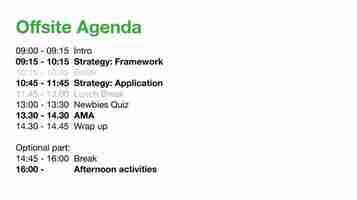Don’t kill your lunch break because of COVID-19 — use it to advance your career
To say that 2020 has been a strange year is undoubtedly the understatement of the century.

As a result of COVID-19, we’ve had to change and adapt at lightning speed — in most cases swapping offices for spare rooms (if you’re one of the lucky ones), and kitchen tables (or beds ) for desks.
These changes come with their own challenges . For example, struggling to stay focused and motivated when working remotely , dealing with countless video calls , and communicating effectively with peers and managers from a distance. The list goes on.
Working from home can also mean you’re working longer hours and even though there’s plenty of literature to suggest that humans work more effectively when they take timely breaks, it seems that most workers are foregoing them.
A recent study by Liberty Games (also covered by Stylist ) found that 41% of British people were likely to work through their lunch breaks while working remotely — and this isn’t OK.
Here’s why:
It’s your right. Unless your contract states otherwise, you’re entitled to a lunch break. Again, it depends on your agreement but most lunch breaks aren’t paid, so why on earth would you want to work for free for an hour each day? Remember you’re giving your employer 5 hours of your time every single week. FOR FREE.
It’s actually good for you . You don’t have to be a rocket scientist to know that regular breaks are good for your concentration levels — and lunch, my friend, is no different.
You need to eat. It’s so easy to sit at your desk all day and forget to do so, but guess what: it’s not good for you. So, don’t do it. Get up, make something delicious, eat it, and savor it.
Try and be as organized as you can. So, meal plan for the week and if you’re able to, make your lunch the night before or make sure there’s plenty of leftovers from dinner so you don’t have to worry about cooking.
The choice is yours … but make lunch count
Planning is key — or else you’ll get bored easily and be tempted to get back to work as soon as possible.
So here’s how to make the most of your break and how to use this time to advance your career.
Exercise during lunch … but make it fun
Have you ever wondered whether you’d enjoy running or pilates? Well, now’s the time to find out.
The likelihood is that you’re probably spending more time sitting down (because, well, your commute is probably a thing of the past ) so there’s never been a better time to get moving and why not have fun while you do.
Think about what kind of exercise you enjoy and try and find online classes. You don’t even have to spend, you can find plenty of free exercise and stretching routines online . If you go down this route, try and watch them on a different device , such as your smartphone , to make sure you reduce work-related screen time.
If classes aren’t your thing, create your own workout routine. Personally, I’m a big fan of the sanity squat . This way, you can get your daily exercise done and also get those endorphins going, meaning you’ll return to feeling happier and refreshed — and be way more productive.
Do your house chores … but quickly
Have you ever stopped to think about how much time house and life admin steals away from you? No, me neither, but I guarantee it’s (probably) a lot.
So, even though this might sound weird, you should totally consider taking care of household chores during your lunch break.
By getting this out of the way at lunch, it means you’ll be able to focus on work during working hours.
I mean, I know I’ve certainly been distracted by laundry while working from home .
Dream … but make your desired career a reality
How women entrepreneurs in India are challenging social and cultural norms
In India, the proportion of women in paid work is among the lowest in the world, at just over 23% – a figure which contrasts sharply with the corresponding rate of over 78% for men.

Opportunities for women to enter employment in the country are limited by a range of factors. These include a dominant tradition of female domestic responsibility and prevailing social patriarchy .
Deeply entrenched cultural expectations mean that women are more likely to stay at home. And when they do work, it is mainly on an informal basis, without the luxury of secured wages and contracts .
Against this backdrop, the idea of female entrepreneurship in India faces major challenges. Setting up a business can require significant efforts outside of normal work times, and can lead to women being perceived as irresponsible if they dedicate time to entrepreneurial activities.
But it seems as if things may be changing. My research on women entrepreneurs in India reveals they are contesting social, cultural, and family pressures to challenge the status quo in Indian society. They are also empowering other women while providing innovative solutions to major social problems.
Some of the women I spoke to greatly inspired me with their stories. One manufacturing business founder, Pinky Maheshwari, was challenged by her son to make environmentally friendly paper. She went on to create handmade paper made out of cotton that is embedded with seeds. These can then be planted and grown into trees when the paper has served its purpose.
Her award-winning ideas have won appreciation and support from the highest levels of the Indian government. She is, she told me, motivated by the idea of empowering others, and “hires women from rural and small towns so that they earn a livelihood and get acknowledged for their creativity.”
She added: “I have employed largely women and I support them in any way I can.”
A similar spirit shone through other women entrepreneurs I interviewed. Padmaja Narsipur, the founder of a digital marketing strategy firm, supports women “re-starters” to join her workforce after a break in their working lives.
She said: “Women re-starters are highly qualified and committed. I have been one myself. I have built a workplace where trust in employees, giving flexible hours, work from home options, is built into the DNA and it is paying off.”
The CEO of Anthill creations , Pooja Rai has the vision to create “interactive learning environments in public spaces with a primary focus on sustainability,” by using recycled materials to build accessible play areas in remote parts of India.
These are just some of the many Indian women entrepreneurs I met who are creating businesses of real purpose. Despite the cultural obstacles, they are changing perceptions and creating innovative businesses that have a real impact on their communities and beyond.
Their work is rewriting the rules for business, families, and society while challenging the mindset that there is limited scope for them to create good businesses.
With a blend of social purpose and business acumen , Indian women are embarking on a journey to change perceptions and creating prosperity for themselves and for the nation.
This is the new face of women entrepreneurship in India. And there is evidence that public policy is increasingly supportive of this transformation while society is beginning to celebrate their successes .
Indian society is gradually becoming progressively egalitarian with much-needed government initiatives such as “Beti Padhao, Beti Bachao” (Save the Daughter, Educate the Daughter) designed to improve the prospects of young girls.
Improved access to social media , education , and social enterprises are all contributing to change. These are giving momentum to the aspirations of women entrepreneurs in India.
Their stories will hopefully inspire women entrepreneurs from around the world while encouraging policy makers to create avenues that support their aspirations.
Such policies could include promoting entrepreneurship education amongst women and helping to finance women-led startups. The work has started, but there is much more to do to encourage the female businesswomen of India to overcome historically entrenched barriers and become part of a global entrepreneurial society.
This article is republished from The Conversation by Mili Shrivastava , Lecturer in Strategy, Bournemouth University under a Creative Commons license. Read the original article .
15 tips for hosting a virtual offsite for your remote team
It was January 2020 and our 140+ team had just gathered in a large hotel conference room for another one of our bi-annual offsites. Ahead lay the whole day and night of strategic team alignment and most importantly — relationship building.

Today, several months and hundreds of Zoom calls later, all this seems like a luxury.
Our whole personal and professional lives seem to have moved online, and so have our company meetings and events.
But even within the boundaries of the online world, it is possible to pull off an impactful company event.
Our first ever fully remote offsite that we recently ran in our company has seen truly positive feedback from our colleagues, along with a wonderful 5.4/6 in a feedback survey.
To inspire you, here are the 15 steps we took in planning and facilitating this full-day virtual event.
PREPARATION PHASE
1. Cut the agenda in half
Compared to meeting in a physical space, virtual offsite is a whole new game. Online, people’s attention is much more susceptible to dropping, so not overcomplicating the agenda is key here.
Keep it simple and short. For instance, we replaced our usual full-day-long program with only three 60-minute content blocks.
We started with the most information-heavy session on the company strategy in the morning when the team was still fresh, which was then continued after a longer break. We finished off the main program with an interactive Q&A session that was fully driven by our team’s questions.
This is what our agenda looked like in overview:


2. Use long and frequent breaks
Even if you shorten the content blocks, don’t forget to factor in long and frequent breaks. People need to recharge before they can process new information. Otherwise, Zoom fatigue may easily take hold of them and lead your colleagues’ attention astray past the point of no return.
This is why we built in one 30-minute break in between the two morning sessions, and one longer 75-minute break for lunch. We also encouraged our people to move away from their screens and go for a walk, so they could start the new content block afresh. When we closed the official part, we had another 30-minute break before the evening fun activities.
3. Simplify the main message
Offsites are high-stakes meetings. This one definitely was for us. We were to present the new strategy for the upcoming 2-3 years. It was critical for us to make sure it was clear and that it stuck with our team. For this reason, we cut all the fluff, and all the unnecessary spin offs and details.
We wrapped the whole narrative around one single topic — our new strategy. To make it more tangible for our team, we used an analogy of climbing the El Capitan mountain wall without a rope (inspired by Alex Honnold’s incredible free soloing achievement).
The team really appreciated the simplified flow. In fact, a lot of feedback comments said that sticking to an overarching topic without fragmenting the content made this offsite so valuable.
4. Assign roles
It takes a team to deliver a successful offsite. There are four key roles that you need to take onboard and align with, from the very first to the last moment:
Content owner — This is typically a CEO (or other person/s from the executive team) who owns the key message. You need to align with them regarding the agenda, main content, and the overall flow.
Moderator — A good moderator is indispensable for delivering an engaging offsite. Their job is to facilitate the opening, monitor the engagement, voice the team questions, and help the speakers deliver the message.
Coordinator — Coordinators are your silent heroes. They help you bring all the pieces together; communicate instructions to the team, chase missing slides, monitor the chat, and manage practically everything that occurs in between.
Tech support — Technology needs to run like a well-oiled machine, otherwise all else may easily crumble apart. In order to make sure it doesn’t, invite your IT manager to oversee the tech stack.
5. Set up a remote studio
This was a game changer for us. If possible, set up a small studio in your office and deliver your offsite from there. Not only was the audio and video quality much better, but it also boosted the energy and the overall vibe of the event ten fold.
It also made the whole event more professional. As one of our teammates mentioned in the feedback comment, “It really makes a huge difference seeing the presenters standing in an office, as opposed to sitting behind their desk at home.”
6. Get the right tool stack
Speaking of tech setup, another great hack that changed our game was the use of one single master deck that we shared with all speakers before the offsite where they were able to paste their slides.
This is most helpful when screen-sharing content during a video call as you don’t have to switch presentation decks — all content can run from one place.
Just like with all our meetings, we used Google Slides along with our own Slido for Google Slides integration . This allowed us to put polls directly into the presentation and run them seamlessly from one place — a great way to streamline engagement.
By the way, here is the tech stack we used: Zoom, Google Slides, Slido, Logitech HD Pro Webcam C920, and Jabra SPEAK 510.
7. Have a dry run with all team leads
One day before the curtain went up, we invited every functional team lead in the company for a dry run. All of us involved hopped on a 4-hour call together, where we ran through all the content that would be shared during the offsite.
The reason why we wanted to familiarize the company leads with the content was twofold:
First, to hear their unbiased feedback.
Second, to inform them on the key messages that we planned to communicate to everyone.
This approachhelped us reach alignment and identify any possible pitfalls.
DELIVERY PHASE
8. Create a fun opening
The offsite is no ordinary meeting. You’ve got everyone together on one video call. Make it special.
Invite colleagues with special talents — musicians, stand-up comics, dancers, you name it — to be part of the opening.
We opened our offsite with a musical number! As people were joining the call, our colleague, Zuzana, played a mini concert for us on her ukulele. Mind you, she’s a ball of energy with or without the ukulele, so imagine the smiles that constantly spread through our team’s faces!
9. Use polls to check if the team is following
Despite a well-crafted story and engaging content, large online events such as this makes it really hard for you to “read the room.”
Polls are your great helpers here. You can easily check if the team is following the main message, or get their instant feedback. In seconds, you can collect data from your whole team — whether it is a dozen, a hundred, or a thousand people.
We ran polls approximately every 5-10 minutes to re-engage our team and hear their thoughts. Here are a few Slido polls that we used.
10. Have a moderator to facilitate the flow
Just as a football match needs a commentator, your offsite needs a moderator to help deliver, facilitate, and steer the whole event forward.
During an offsite, a moderator is there to guide co-workers through the meeting, bring them back into context after the breaks, keep an eye on handovers, pose team’s impromptu questions to the speakers, or bring in fun comments from the chat.
You can either ask a colleague with the right facilitation skills to moderate the offsite, or in case there’s no such person available, seek a professional. In any event, it will be worth it.
11. Use Zoom breakout rooms for small group discussions
New information sparks lots of questions. Create a space for your team to digest what they’ve just heard and discuss it together in small groups.
In the second content block, we dedicated 20 minutes to small group discussions. Zoom breakout rooms proved invaluable here. We split the team randomly into groups of three to four people.
The assignment was simple: “Share your thoughts and discuss the new strategy. Then come up with questions about anything that is not clear.”
For some it was the highlight of the meeting: “Breakout rooms were an amazing move! It was so nice to talk to random people in a sort of round-table setup.”
12. Collect team’s questions strategically
Offsites are a unique opportunity to address the team’s questions. And you can be sure that the team will have plenty of those — especially after you’ve just introduced a new strategy.
Here’s what we did. Once the discussions in breakout rooms were over (previous point), we asked our team to go to Slido Q&A and post their questions there.
Of course, there were questions in Slido even before the discussions, but we collected over 35 new questions after this exercise alone! That’s a lot of points to discuss and clarify.
But what can you do to make the Q&A as effective and worthwhile as possible?
13. Run Q&A session as a conversation (moderator and CEO)
Q&A may well become the most important element of your offsite, but you need to get it right. Don’t let your CEO or exec team just read from the questions that the team have submitted and then address them one by one.
Instead, let the moderator read the questions to the CEO. This will make your Q&A seem like a natural conversation and take your Q&A session from 1 to 100.
Another thing that can move the discussion forward is upvoting. Tell your team to vote for the questions they find most relevant, so the most popular ones make it to the top and get answered with priority. That’s really powerful and can transform your whole Q&A session.
14. Wrap up the key message before you let people go
Repetition is the mother of all learning, so if you want your message to stick, you need to repeat it. Again. And again.
Before you wrap up, bring the key message back on the slide and let it sink in.
Oh, and before getting off the call, don’t forget to ask people for feedback. Keep the feedback questions simple and easy to complete — like when you rate your UBER rides. Combine star-rating with open text comments, it will help you improve your next offsite.
15. Make space for socializing and fun online activities
Finally, offsites don’t need to be only about company strategy and alignment in the business sense of the word. Create a space for social activities, like quizzes or online games, and help your team relax and let their hair down a little — even online!
We ran a newbies quiz just after lunch to pull people back in and enjoy some friendly competition together. We collected some fun facts about our newest team members, turned them into a quiz, and let our team guess away. It was fun — we even got some sweet prizes for the winners.
After we wrapped up the official part, some people from our team divided into groups and played games such as Murder Mystery or Counter Strike. Let your creative juices flow!